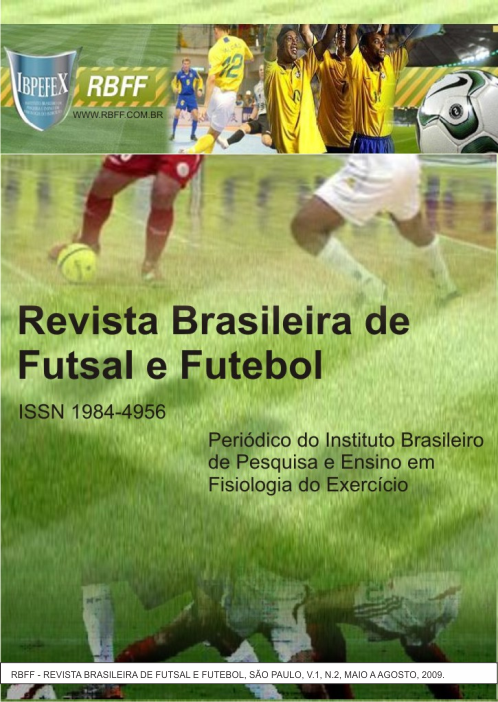Characterization of physical exertion in the U-20 Futsal
Abstract
The evolution of the futsal has taken to increase of scientific production in this area, providing a better knowledge of this sport, consequently, a better trained athlete, able to attend the necessities of this modality. The purpose of this study was measuring the dislocation of young players during futsal soccer matches. Observing the subject researches it was noticed that there are studies which measured physical exertion according to its intensity, kind and volume of specific dislocation for tactical position in the playing-field. For the development of this research was used 6 futsal players until 20 years old. Through the video tape record was defined the specific step length of the athletes walking, jogging, running fast, walking backwards, jogging backwards and moving sideways. Afterwards the athletes was filmed individually in 4 matches and the distance covered for each player in every type of locomotion was calculated through the multiplication of number of steps during the game by the specific step length of the person. The total distance average covered by the athletes was 2,432.35 meters. Walking was the type of movement that occurred more frequently, having the athletes covered in average 75.01 meters distance every minute. In relation to the intensity predominated the low ones, followed by the medium ones and at last the high intensity. Observing the results could be noticed that the distance covered in the different patterns of the movement vary from one athlete to another, as well as the percentage of activities of high, medium and low intensity. The relation between activities of high and low intensity was in average 1 to 3. This results suggest that futsal characterizes as a sport that demands intermittent exertion, where the player must be able to covered distances over 3,483 meters.
References
- Altimari, L. R.; Okano, A. H.; Coelho, C. F.; Cyrino, E. S. Efeitos do Treinamento de Futsal sobre o Desempenho Motor em Atividades Predominantemente Aeróbias e Anaeróbias. Revista Treinamento Desportivo. Londrina. Vol. 4. Num. 3. 1999. p. 23-28.
- Araújo, T. L.; Andrade, D. R.; Figueira Júnior, A. J.; Ferreira, M. Demanda Fisiológica Durante o Jogo de Futebol de Salão, Através da Distância Percorrida. Revista da Associação dos Professores de Educação Física de Londrina. Londrina. Vol. 11. Num. 19. 1996. p. 12-20.
- Bello Júnior, N. A Ciência do Esporte Aplicada ao Futsal. Rio de Janeiro. Sprint. 1998.
- Carr, G. Biomecânica dos Esportes. São Paulo. Manole. 1998.
- De Paula, A. I.; De Castro, E. M.; Cozzani, M. V. Desenvolvimento Longitudinal do Andar para Frente e do Andar para Trás: Impacto da Restrição Ambiental. Revista Brasileira de Cineantropometria e Desempenho Humano. Florianópolis. Vol. 8. Num. 4. 2006. p. 73-81.
- Gallahue, D. L.; Ozmun, J. C. Compreendendo o Desenvolvimento Motor: Bebês, Crianças, Adolescentes e Adultos. 3ª edição. São Paulo. Phorte. 2005.
- Kokubun, E.; Molina, R.; Ananias, G. E. O. Analise de Deslocamentos em Partidas de Basquetebol e de Futebol de Campo: Estudo Exploratório Através da Análise de Séries Temporais. Revista Motriz. Rio Claro. Vol. 2. Num. 1. 1996. p. 20-25.
- Leal, F.; Mussio, F. B.; Almeida, D. A. Processo Interativo de Aprendizagem do Cálculo do Tempo Padrão Através de uma Ferramenta Visual. In: X Simpósio de Engenharia de Produção. Bauru. 2003. http://www.simpep.feb.unesp.br/Anais%20X%20SIMPEP.htm Acessado em 15/05/2007.
- Mann, R. A.; Hagy, J. Biomechanics of Walking, Running and Sprinting. The American Journal of Sports Medicine. Vol. 8. 1980. p. 345-350.
- Molina, R. Lactato Sangüíneo em Partida de Futsal: Relações com o Condicionamento Físico e com o Desempenho. Rio Claro. UNESP. 1996. 153p.
- Oliveira, P. R.; Amorim, C. E. N.; Goulart, L, F. Estudo do Esforço Físico no Futebol Júnior. Revista Paranaense de Educação Física. Curitiba. Vol. 1. Num. 2. 2000. p. 49-58.
- Reilly, T.; Thomas, V. A Motion Analysis of Work-Rate in Different Positional Roles in Professional Football Match-Play. Journal of Human Movement Studies. Vol. 2. Num 1. 1976. p. 87-97.
- Soares, B.; Tourinho Filho, H. Análise da Distância e Intensidade dos Deslocamentos, numa Partida de Futsal, nas Diferentes Posições de Jogo. Revista Brasileira de Educação Física e Esporte. São Paulo. Vol. 20. Num. 2. 2006. p. 93-101.
- Withers, R. T.; Maricic, Z.; Wasilewski, S.; Kelly, L. Match Analyses of Australian Professional Soccer Players. Journal of Human Movement Studies. Vol. 8. 1982. p. 159-176.
Authors who publish in this journal agree to the following terms:
- Authors retain the copyright and grant the journal the right of first publication, with work simultaneously licensed under the Creative Commons Attribution License BY-NC which allows the sharing of the work with acknowledgment of the authorship of the work and initial publication in this journal.
- Authors are authorized to enter into additional contracts separately for non-exclusive distribution of the version of the work published in this journal (eg, publishing in institutional repository or book chapter), with acknowledgment of authorship and initial publication in this journal.
- Authors are allowed and encouraged to post and distribute their work online (eg, in institutional repositories or on their personal page) at any point before or during the editorial process, as this can bring about productive change as well as increase impact and impact. citation of published work (See The Effect of Free Access).





